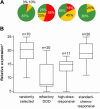Resistance to platinum-containing chemotherapy in testicular germ cell tumors is associated with downregulation of the protein kinase SRPK1
- PMID: 15256051
- PMCID: PMC1502111
- DOI: 10.1593/neo.03406
Resistance to platinum-containing chemotherapy in testicular germ cell tumors is associated with downregulation of the protein kinase SRPK1
Abstract
Male germ cell tumors (GCTs) are extremely sensitive to platinum-containing chemotherapy, with only 10% of patients showing therapy resistance. However, the biological basis of the high curability of disseminated GCTs by chemotherapy is still unknown. Recently, we demonstrated that the mammalian serine/arginine-rich protein-specific kinase 1 (SRPK1) is a cisplatin-sensitive gene, inactivation of which leads to cisplatin resistance. Because, in mammalians, the expression of SRPK1 is preferentially high in testicular tissues, cisplatin responsiveness of male GCTs might be associated with SRPK1 levels. In the present study, we monitored SRPK1 protein expression in a unique series of nonseminomatous GCTs by immunohistochemistry. Randomly selected GCTs (n = 70) and tumors from patients responding to standard chemotherapy (n = 20) generally showed strong SRPK1 staining. In contrast, expression in refractory GCTs (n = 20) as well as in GCTs from poor-prognosis patients responding to high-dose chemotherapy only (n = 11) was significantly lower (two-sided Wilcoxon rank sum test: P < .001). In conclusion, our data suggest that SRPK1 expression might be an important prognostic indicator for the chemoresponsiveness of nonseminomatous GCTs.
Copyright 2004 Neoplasia Press, Inc.
Figures


Similar articles
-
Molecular determinants of treatment response in human germ cell tumors.Clin Cancer Res. 2003 Feb;9(2):767-73. Clin Cancer Res. 2003. PMID: 12576448
-
Combination of paclitaxel, ifosfamide, and cisplatin is an effective second-line therapy for patients with relapsed testicular germ cell tumors.J Clin Oncol. 2005 Sep 20;23(27):6549-55. doi: 10.1200/JCO.2005.19.638. J Clin Oncol. 2005. PMID: 16170162 Clinical Trial.
-
Human germ cell tumours: expression of gamma-glutamyl transpeptidase and sensitivity to cisplatin.Br J Cancer. 1999 Sep;81(1):75-9. doi: 10.1038/sj.bjc.6690653. Br J Cancer. 1999. PMID: 10487615 Free PMC article.
-
The use of dose-intensified chemotherapy in the treatment of metastatic nonseminomatous testicular germ cell tumors. German Testicular Cancer Study Group.Semin Oncol. 1998 Apr;25(2 Suppl 4):24-32; discussion 45-8. Semin Oncol. 1998. PMID: 9578059 Review.
-
[Chemotherapy of disseminated germ cell tumors].Gan To Kagaku Ryoho. 1998 Oct;25(12):1873-90. Gan To Kagaku Ryoho. 1998. PMID: 9797810 Review. Japanese.
Cited by
-
A review of the past, present, and future directions of neoplasia.Neoplasia. 2005 Dec;7(12):1039-46. doi: 10.1593/neo.05793. Neoplasia. 2005. PMID: 16354585 Free PMC article. Review. No abstract available.
-
Connecting the speckles: Splicing kinases and their role in tumorigenesis and treatment response.Nucleus. 2015;6(4):279-88. doi: 10.1080/19491034.2015.1062194. Epub 2015 Jun 22. Nucleus. 2015. PMID: 26098145 Free PMC article. Review.
-
Good Cop, Bad Cop: The Different Roles of SRPKs.Front Genet. 2022 Jun 2;13:902718. doi: 10.3389/fgene.2022.902718. eCollection 2022. Front Genet. 2022. PMID: 35719374 Free PMC article. Review.
-
Targeting pre-mRNA splicing in cancers: roles, inhibitors, and therapeutic opportunities.Front Oncol. 2023 Jun 5;13:1152087. doi: 10.3389/fonc.2023.1152087. eCollection 2023. Front Oncol. 2023. PMID: 37342192 Free PMC article. Review.
-
Mitotic spindle proteomics in Chinese hamster ovary cells.PLoS One. 2011;6(5):e20489. doi: 10.1371/journal.pone.0020489. Epub 2011 May 27. PLoS One. 2011. PMID: 21647379 Free PMC article.
References
-
- Johnson SW, Ferry KV, Hamilton TC. Recent insight into platinum drug resistance in cancer. Drug Resist Updates. 1998;1:243–254. - PubMed
-
- Perez RP. Cellular and molecular determinants of cisplatin resistance. Eur J Cancer. 1998;34:1535–1542. - PubMed
-
- Niedner H, Christen R, Lin X, Kondo A, Howell SB. Identification of genes that mediate sensitivity to cisplatin. Mol Pharmacol. 2001;60:1153–1160. - PubMed
-
- Burger H, Capello A, Schenk PW, Stoter G, Brouwer J, Nooter K. A genome-wide screening in Saccharomyces cerevisiae for genes that confer resistance to the anticancer agent cisplatin. Biochem Biophys Res Commun. 2000;269:767–774. - PubMed
-
- Schenk PW, Boersma AWM, Brandsma JA, den Dulk H, Burger H, Stoter G, Brouwer J, Nooter K. SKY1 is involved in cisplatin-induced cell kill in Saccharomyces cerevisiae and inactivation of its human homologue, SRPK1, induces cisplatin resistance in a human ovarian carcinoma cell line. Cancer Res. 2001;61:6982–6986. - PubMed
MeSH terms
Substances
LinkOut - more resources
Full Text Sources
Medical
